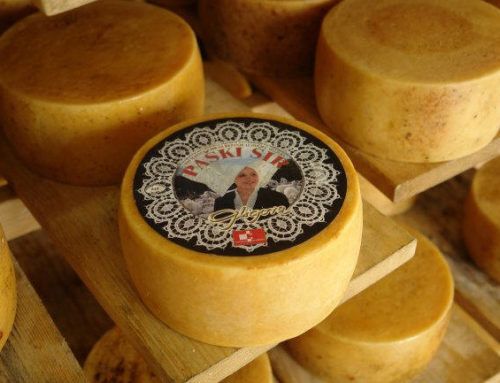Maple Sugar: America’s First Sweetener
Maple sugar is an indigenous nutrient-rich sugar that the native Indians found more transportable than maple syrup.
Maple sugar, or dehydrated maple syrup, was the New World’s first natural sweetener and is one of the most authentic “American” gifts you can give someone–along with maple syrup. Long before European settlers arrived with the European honeybee to make honey, American Indians dwelling in the Northeast were setting up sugaring camps among the plentiful sugar maple trees each spring. These camps produced an indigenous nutrient-rich sweetener high in minerals.
The Indian process of sugar making, crude by modern-day standards, employed hollowed out logs, heated rocks for evaporating the sap, and handmade birch bark containers for collecting the sap and storing the maple sugar. Most of the tribes boiled and crystallized the sap they collected into a granulated maple sugar—bypassing the syrup stage as syrup was harder to store—ending up with a more transportable sweetener.
Indian folk tales present several different versions of how it all began. One legend tells the story of an Iroquois chief who threw his tomahawk into a maple tree one early March eve. When he retrieved it the following morning to go hunting, he noticed sap oozing from the cut in the tree. He collected some in a container and his wife added some of the syrup to the meat she was cooking for dinner. As the sap boiled down, a wonderful sweet maple flavor remained.
Although the Indians couldn’t scientifically analyze the sweet ooze, they recognized it as a valuable food commodity–and a sweet addition to their foods. Today, scientists know it’s composed of 88-89 percent sucrose, with fructose and glucose making up the rest. Maple sugar is particularly rich in potassium, containing from 1,300 to 3,900 ppm, and calcium, containing from 400-2,100 ppm, depending on the source. Other trace minerals present in appreciable amounts include magnesium, manganese and phosphorous. Maple products also contain trace amounts of malic and citric acids, as well as some amino acids.
I love maple sugar and wonder why it is not more popular and available. (If you’ve ever made sweetened whipped cream with maple sugar, you will never want to use anything else.) Many recipes in old New England cookbooks call for “Indian sugar,” but few modern cooks have ever heard about it. Maple farmers sell granulated maple sugar directly to consumers under different names, such as maple powder, maple sprinkles or maple granules. I wholeheartedly recommend it for baking or making candy but suggest you buy it in bulk (or it is astronomically expensive). But it can be hard to find because very few syrup makers want to go the extra step to make maple sugar. Vermont and Quebec are the two main source areas for maple sugar–and where get the supply I sell. To get the best price you have to buy 100 lbs. or more–so that’s a good reason to buy from me.
As it turns out, the reason maple sugar became less popular and almost disappeared from the American culture was the rise of cheap white sugar produced by slavery in the West Indies. Hoping to keep America independent and not reliant on cane sugar or beet sugar imported from other countries, Thomas Jefferson, who was as much a connoisseur of fine food as a statesman, championed the native maple sugar tree. In 1808 he wrote, “I have never seen a reason why every farmer should not have a sugar orchard, as well as an apple orchard.” Ironically, even though white cane sugar began to undersell maple sugar, the popularity of maple syrup started to grow which helped preserve the American maple tradition.
By the way, the maple industry takes its maple sugar very seriously. Recently, a Vermont sugar maker was sentenced to four years in a federal prison for selling more than 500,000 pounds of what was claimed to be maple sugar which was in fact almost entirely cane sugar. A jury found W. Lyman Jenkins guilty on twenty counts of fraud and the introduction of adulterated food into interstate commerce laws. With cane sugar selling for somewhere around twenty cents a pound and the price of bulk maple sugar valued at $3.50 per pound and retailing at $4.95 and up, it’s not too hard to see why Jenkins was tempted. However, the severity of the sentence—one applauded by the maple sugar industry as a whole—should send a clear sign throughout the industry that tampering with the purity of maple sugar will not be tolerated.
Indian Sugar Fudge
Maple sugar, sometimes called Indian sugar, and cream make this extraordinary fudge. The cream you choose will make a difference. Thin cream will make harder fudge, while a thick cream with more butterfat will make a softer fudge.
- 1 pound (about 2 3/4 cups ) maple sugar
- 3/4 cup thin cream
- 1/4 cup boiling water
- 2/3 cup walnuts or pecans
Put sugar in saucepan with cream and water, bring to boil and boil to soft ball stage, 240°F. Remove from the heat and beat until creamy*, add nuts and pour into a buttered stainless steel baking pan. Cool and cut. (*You should see crystallization begin within two minutes. If this does not happen, you need to reheat the mixture to a couple of degrees higher.)
Maple Orange Frosting
This frosting from Vermont Country Naturals is the perfect frosting for carrot cake or cupcakes.
- 1/4 cup butter, softened
- 1 1/3 cups maple sugar
- 2 tablespoons fresh orange juice
- more juice or water if needed
Whip the butter with maple sugar in a medium mixing bowl. Add the orange juice and beat with an electric mixer. Make sure the frosting is thoroughly blended before deciding to add more liquid, a little bit at a time, until the desired consistency is achieved.
Maple Crème Chantilly
Crème chantilly is French for sweetened whipped cream. Once you taste whipped cream sweetened with maple sugar, you won’t want it any other way.
- 2 cups whipping cream
- 1 teaspoon vanilla
- 2-4 tablespoons maple sugar
Start to whip the cream; add the vanilla all at once and the maple sugar tablespoon by tablespoon until you reach the desired sweetness.
North-South Rhubarb Compote
This recipe combines two northern, cold-climate foods with one from the tropics to create a simple and delicious dessert. The further north one goes, the better the conditions for growing rhubarb, so it’s not surprising that almost every garden in Quebec has a patch. Coincidentally, Quebec produces 70 percent of the world’s maple sugar. Rhubarb and maple sugar are delightfully complementary—and orange juice adds a splash of sun.
- 4 cups rhubarb, cut into ½-inch pieces
- 2 cups fresh squeezed orange juice
- 1 cup granulated maple sugar
Put all ingredients in a medium-sized pan and bring to a slow simmer. Cook until the rhubarb is soft and the mixture achieves the consistency of a thick sauce. Remove from the heat and cool slightly to serve warm or refrigerate overnight to serve cold. Refrigeration will naturally thicken the mixture into the consistency of a pudding. Serve with whipped cream.
For more information:
- Richard Sweterlisch, “Mud Season Harvest: Maple Sugaring in Vermont,” Richard Sweterlitsch, The World & I, March 1992.
- James M. Lawrence and Rex Martin, Sweet Maple: Life, Lore & Recipes from the Sugarbush, Chapters Publishing, Ltd., Shelburne, Vermont, 1993.
- The Official Vermont Maple Cookbook, available for $2 from the Vermont Maple Promotion Board, 116 State Street, Drawer 20, Montpelier, VT 05620.
A version of this article first appeared in Wise Traditions, the quarterly journal of the Weston A. Price Foundation.


Leave A Comment